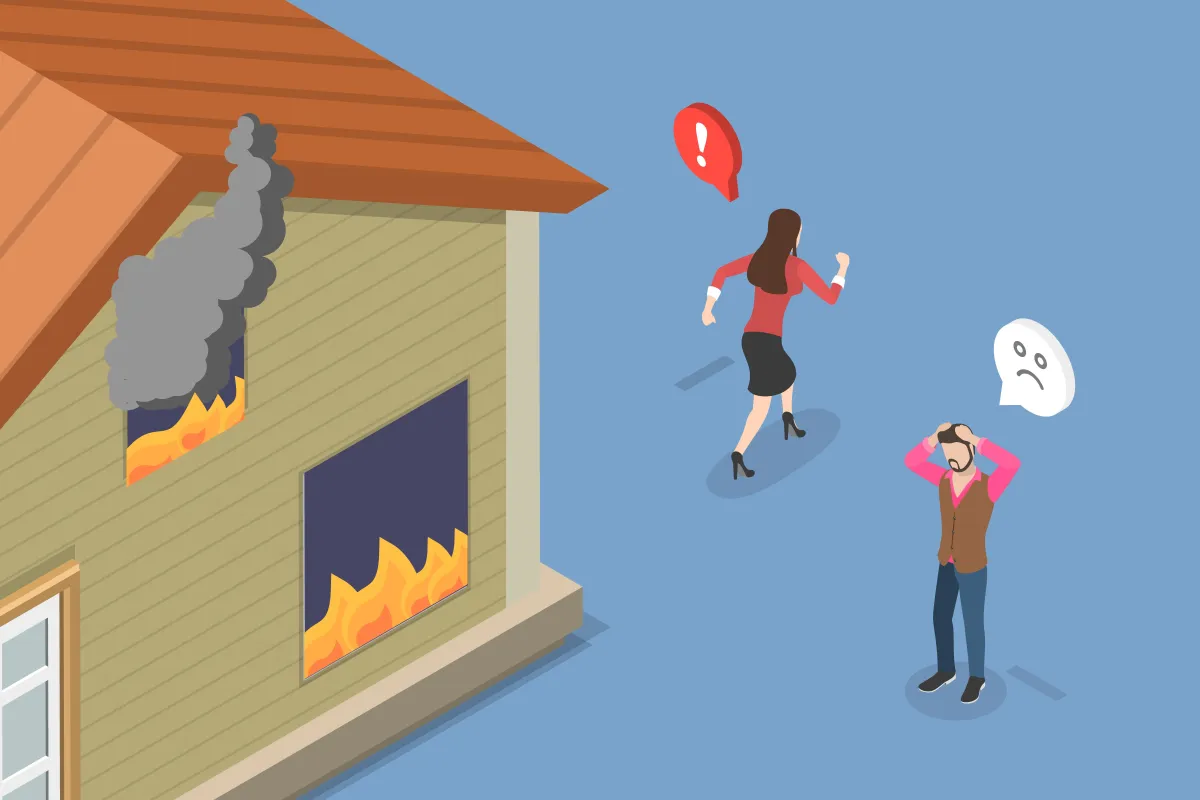
Understanding Home Insurance - Loss of Use Coverage (Coverage D)
Disclaimer: The content on our blog is intended for general informational and educational purposes only and should not be considered a substitute for professional advice. Insurance needs vary widely, and because insurance companies and policies differ, readers should consult with their insurance agent for personalized guidance. While we strive for accuracy and regularly update our content, we cannot guarantee its completeness or timeliness. HonestFlow is not responsible for any actions taken on insurance policies based on the information provided on our blog.
What is Loss of Use Coverage?

Imagine your home is damaged by a fire, storm, or another disaster covered by your home insurance policy, making it temporarily uninhabitable. During these challenging times, Loss of Use coverage, or Coverage D, becomes essential. This coverage supports you financially by covering reasonable additional living expenses incurred because you cannot live in your home while it is being repaired or rebuilt.
Why is Coverage D Important?
When a disaster such as a fire, storm, or other covered peril forces you out of your home, the costs of temporary living arrangements can add up quickly. Have you considered the expenses you'll face if a wildfire, hurricane, or other natural disaster requires a mandatory evacuation? What if you have to live away from home while it’s being repaired from a covered loss? Loss of Use Coverage helps cover expenses like hotel bills, restaurant meals, and other reasonable living costs incurred while your home is not available. Without this coverage, homeowners might struggle to afford these additional expenses, potentially leading to financial hardship.
What’s Covered under Coverage D?

This table provides a general overview of coverage and exclusions under Coverage D (Loss of Use). The specifics of your policy can vary based on your insurance carrier and individual policy details. For accurate and detailed information about your coverage, please consult with your insurance agent.
✅ Temporary Housing and Living Expenses
Coverage D covers the costs of temporary housing if your home is uninhabitable due to a covered loss. This can include expenses for temporary housing, food expenses, storage fees, and additional transportation costs if your temporary residence is further from your work or school.
🔍 Scope of Coverage
Loss of Use coverage is typically set as a percentage of your Coverage A limit, usually ranging from 10% to 30% or more. It's crucial to consider the actual dollar amount this percentage represents to understand the extent of coverage your policy provides, given that Coverage A (Dwelling) usually includes substantial coverage. Additionally, access to this coverage may be limited to a certain timeframe after the loss occurs. Working with insurance agents can help you understand how much coverage you have and how long you have to access it.
❌ Understanding Exclusions
While Coverage D is comprehensive, it does not cover every situation. For instance, if you're displaced due to a flood or an earthquake and these perils are excluded under your standard policy, claims may not be approved. Additionally, unreasonable living expenses, such as 5-star hotels and luxury dining, may be excluded by your insurance company. It's important to confirm with your agent which expenses are considered covered under Loss of Use coverage.
Common Coverage D Limits

This table provides a general overview of Coverage D limits. The specific limits and options available can vary by insurance carrier and individual policy details. For accurate and detailed information about your coverage, please consult with your insurance agent.
Coverage D is often set as a percentage of your dwelling coverage, typically ranging from 10% to 30%. For example, if your home is insured for $300,000, your Loss of Use coverage could range from $30,000 (10%) to $90,000 (30%). The amount of coverage you need may vary depending on your situation, as living expenses can differ by location, and some homeowners may have more access to alternative living accommodations than others.
Things To Consider - Coverage D
💡 Claims Process: Imagine your home becoming uninhabitable due to a covered loss. You don’t want to be scrambling to figure out how to access this coverage in this stressful situation. Some insurance companies will ask homeowners to keep receipts of expenses incurred, while others may provide a cash advance. Communicate with your agent to ensure you understand the claims process. Each insurance company has its own methods to compensate for this coverage.
💡 Limitations: Coverage D is usually limited for a certain period of time. If the demand for construction workers are high, say in the event a storm damages many homes in your area, it may take longer than expected until your home is repaired. Knowing these time constraints can help you evaluate temporary living options and appropriate coverage limits.
💡 Coverage Limits: As with any insurance coverage, your policy will only cover expenses up to the specified limits. Any additional costs above these limits will be the homeowner's financial responsibility. Work with your insurance agent to ensure you have adequate coverage for additional living expenses if you are forced out of your home.
How Much Loss of Use Coverage Do I Need?

The amount of Loss of Use Coverage (Coverage D) will vary based on each homeowner’s access to additional living resources and their risk appetite. For example, some homeowners may have a second home or have relatives they can reside with in the event of an emergency. On the other hand, some homeowners may not have additional places to stay, and they would need to find alternative housing while displaced from their home. Also consider how long you may be displaced. If many homes in your area are damaged and there’s a high demand for construction workers, it may take longer than expected until your home is repaired. The key is understanding your unique situation and the range of options available across different carriers. This is where HonestFlow can assist, connecting you with verified agents who can offer personalized Loss of Use coverage recommendations.
Solutions with HonestFlow
By understanding the scope of Loss of Use coverage and establishing adequate coverage limits, you can minimize the likelihood of incurring out-of-pocket expenses if your home is unavailable due to a covered loss. HonestFlow shoppers are connected with verified insurance agents who can navigate your optimal Loss of Use coverage options. With HonestFlow, shoppers decide how many agents to receive quotes from, providing a personalized and controlled shopping experience. Furthermore, HonestFlow shoppers receive our insurance shopping tools, including our "Questions to Consider" guide. If you're in the market for home insurance or considering a change, request home insurance quotes with HonestFlow!

Questions To Consider - Coverage D
At HonestFlow, we believe that selecting the best insurance policy goes beyond finding the lowest premium; it's about getting the right coverage for the best rate, and understanding what your policy actually covers. To support our shoppers with their insurance journey, HonestFlow shoppers receive our 'Questions To Consider' guide, including questions to help navigate coverage options with their agents! Here are a few questions to consider when evaluating Loss of Use Coverage.
1. What type of expenses would this coverage apply to?
Asking this question helps policyholders understand what living expenses are covered if their home becomes uninhabitable due to a covered loss.
2. Is there a time limit for accessing this coverage?
Understand the time limit for this coverage, as some policies may offer Loss of Use benefits until your home is repaired or rebuilt, while others may have a specific cap, such as 12 months.
3. Are there any exclusions or limitations to be aware of?
Confirm which situations or expenses are not included under Loss of Use coverage. Expenses for fine dining and luxury hotels may not be covered.
4. How does the claims process work for Loss of Use?
Understanding the procedure for filing a claim, what documentation is needed, and how reimbursements are handled can streamline the process should you ever need to use this coverage.
5. What is the deductible for Loss of Use claims, if any?
While Loss of Use coverage typically does not require a deductible, it's essential to confirm this with your insurance agent to avoid any surprises during a claim.
©️ 2024 HonestFlow LLC. All Rights Reserved

